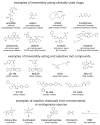Mapping proteome-wide interactions of reactive chemicals using chemoproteomic platforms
- PMID: 26647369
- PMCID: PMC4731263
- DOI: 10.1016/j.cbpa.2015.11.007
Mapping proteome-wide interactions of reactive chemicals using chemoproteomic platforms
Abstract
A large number of pharmaceuticals, endogenous metabolites, and environmental chemicals act through covalent mechanisms with protein targets. Yet, their specific interactions with the proteome still remain poorly defined for most of these reactive chemicals. Deciphering direct protein targets of reactive small-molecules is critical in understanding their biological action, off-target effects, potential toxicological liabilities, and development of safer and more selective agents. Chemoproteomic technologies have arisen as a powerful strategy that enable the assessment of proteome-wide interactions of these irreversible agents directly in complex biological systems. We review here several chemoproteomic strategies that have facilitated our understanding of specific protein interactions of irreversibly-acting pharmaceuticals, endogenous metabolites, and environmental electrophiles to reveal novel pharmacological, biological, and toxicological mechanisms.
Copyright © 2015 Elsevier Ltd. All rights reserved.
Figures



Similar articles
-
Mapping Proteome-Wide Targets of Environmental Chemicals Using Reactivity-Based Chemoproteomic Platforms.Chem Biol. 2015 Oct 22;22(10):1394-405. doi: 10.1016/j.chembiol.2015.09.008. Chem Biol. 2015. PMID: 26496688 Free PMC article.
-
Reimagining Druggability Using Chemoproteomic Platforms.Acc Chem Res. 2021 Apr 6;54(7):1801-1813. doi: 10.1021/acs.accounts.1c00065. Epub 2021 Mar 18. Acc Chem Res. 2021. PMID: 33733731 Review.
-
Uncovering Drug Mechanism of Action by Proteome Wide- Identification of Drug-Binding Proteins.Med Chem. 2017;13(6):526-535. doi: 10.2174/1573406413666170518154724. Med Chem. 2017. PMID: 28523998 Review.
-
Chemoproteomic-enabled phenotypic screening.Cell Chem Biol. 2021 Mar 18;28(3):371-393. doi: 10.1016/j.chembiol.2021.01.012. Epub 2021 Feb 11. Cell Chem Biol. 2021. PMID: 33577749 Review.
-
Mass spectrometry-based chemoproteomic approaches.Methods Mol Biol. 2012;803:3-13. doi: 10.1007/978-1-61779-364-6_1. Methods Mol Biol. 2012. PMID: 22065214 Review.
Cited by
-
Activity-based protein profiling for mapping and pharmacologically interrogating proteome-wide ligandable hotspots.Curr Opin Biotechnol. 2017 Feb;43:25-33. doi: 10.1016/j.copbio.2016.08.003. Epub 2016 Aug 26. Curr Opin Biotechnol. 2017. PMID: 27568596 Free PMC article. Review.
-
Chemoproteomic Profiling of Acetanilide Herbicides Reveals Their Role in Inhibiting Fatty Acid Oxidation.ACS Chem Biol. 2017 Mar 17;12(3):635-642. doi: 10.1021/acschembio.6b01001. Epub 2017 Jan 20. ACS Chem Biol. 2017. PMID: 28094496 Free PMC article.
-
The Key Characteristics of Carcinogens: Relationship to the Hallmarks of Cancer, Relevant Biomarkers, and Assays to Measure Them.Cancer Epidemiol Biomarkers Prev. 2020 Oct;29(10):1887-1903. doi: 10.1158/1055-9965.EPI-19-1346. Epub 2020 Mar 9. Cancer Epidemiol Biomarkers Prev. 2020. PMID: 32152214 Free PMC article.
-
Chemoproteomics-Enabled Covalent Ligand Screening Reveals ALDH3A1 as a Lung Cancer Therapy Target.ACS Chem Biol. 2018 Aug 17;13(8):1970-1977. doi: 10.1021/acschembio.8b00381. Epub 2018 Jul 23. ACS Chem Biol. 2018. PMID: 30004670 Free PMC article.
-
NHS-Esters As Versatile Reactivity-Based Probes for Mapping Proteome-Wide Ligandable Hotspots.ACS Chem Biol. 2017 Jun 16;12(6):1478-1483. doi: 10.1021/acschembio.7b00125. Epub 2017 May 1. ACS Chem Biol. 2017. PMID: 28445029 Free PMC article.
References
Publication types
MeSH terms
Substances
Grants and funding
LinkOut - more resources
Full Text Sources
Other Literature Sources

